skip to main |
skip to sidebar
For some years now, I have made annual visits to Myanmar (formerly Burma) in connection with the educational and medical charitable initiatives managed by Doctor Hla Tun. My last visit to the 'Future Generation' Drop In Centre in Mawlamyine on 24th April 2018 is described in the post here.
I was delighted learn from the Doctor of the success of three of the young people from 'Future Generation' in receiving 'Outstanding Student' awards.

Outstanding Students, Future Generation D.I.C.
In my own country, rather curious ideas seem to have taken over education which can be summarised as "All must have prizes". Testing has been downgraded and failure is not recognised. Whilst I agree that young people should not be humiliated for finding difficulty with learning, removing the urge to strive helps no-one. When young people grow up, the world outside will certainly punish failure so preparing them at an earlier age in a sympathetic environment is a kindness. Education in Burma remains similar to what I was used to all those years ago when I was at school. I didn't enjoy it much at the time, but I was better prepared for adult life.
Congratulations!
More pictures
Outstanding Students, Future Generation D.I.C.
I made a brief visit to Blackpool on Saturday, 9th February 2019.
Seaside resorts out-of-season have appealed to me for a long time and I wanted to travel between Preston and Blackpool to see the now-completed railway electrification. Although strong winds were forecast, it looked as if the Saturday had the best chance of being dry with some sunshine so I pre-booked tickets on the internet the day before to be collected from Wolverhampton station as I departed on the Saturday. I'd booked to 'Blackpool (Any)' and the 'best connection' from Preston on the outward journey was shown as to Blackpool South. An ordinary ticket now costs around eighty (80) times what I paid for a trip in 1957 which is recollected here.
This was my first trip to Blackpool for almost three years (that trip is described starting here). Using our local bus service to get from my home to Wolverhampton, the earliest train I could catch was the 09:37 Virgin 'Pendolino', changing at Preston. The Virgin train was supposed to continue to Glasgow but strong winds earlier in the week had brought down the Overhead Line equipment somewhere on the route in Scotland and so my train was terminating at Preston where passengers travelling further north were advised to seek further information. The journey to Preston was on time but, for some reason, the ride quality in the leading vehicle was impaired, causing me to feel quite queasy. Finally, at Wigan, I moved to the second vehicle and remained standing for the remainder of the journey to Preston.
At Preston, I made my way across to island platform 1/2 used by the Fylde Line local trains operated by 'Northern'. This franchise replaced the previous 'Northern Rail' in April 2016. A Class 142 'Pacer' was shut down in platform 2 with the doors open and people boarding but no destination showing on the route blind. The electronic Passenger Information Display on the platform indicated that this train would shortly depart for Blackpool South (for some reason, a few minutes minutes earlier than the time the internet booking system had shown) so I climbed on board. After a short wait a driver arrived, started the engines and set the route blind. A 'Sprinter' arrived from the north in platform 1 which I correctly guessed was the service from Blackpool North.
Almost immediately, my own train set off, negotiated the curving route leaving the station and passed Preston Power Signal Box. I always feel slightly 'proprietorial' about Preston Power Signal Box because I visited it a number of times during the 1970s when my firm was designing and building telecommunications equipment for the West Coast Main Line Electrification Project (our involvement is briefly described here).

Preston to Blackpool South: North end of Preston station with the Power Signal Box half-hidden by a stabled Class 319 (refurbished after 'cascade' from the London area).
In the shadow of the imposing St. Walburge's Church, my train swung left onto the route for the coast, leaving the West Coast Main Line which continues north on the other side of the church. In the steam era, the route from Preston to Kirkham and Wesham was four-track, paired by use, but simple double track has sufficed more recently. For some distance near Preston, the disused formation which once carried the 'Fast' lines has been taken over by a road. We passed a new LED colour light signal with the identification 'BL' and four digits, indicating that we had left the Preston Power Box area and were now under the control of the Manchester Rail Operating Centre (ROC). This facility, located in Ashburys, was opened in July 2014. We were running 'under the wires'but, of course, burning diesel fuel. I've despised the four-wheeled 'Pacers' since they were introduced as a 'cheap' alternative to 'proper' trains but I was happy to note that, running on Continuous Welded Rail (CWR), the ride was considerably better than I'm used to. We bowled along past a succession of mainly automatic LED colour light signals past Salwick to our first stop at Kirkham and Wesham.
In the steam era, the Slow Lines served a single island platform whilst the Fast lines on the north side of the Slow Lines were used by 'through' trains. The Lancashire and Yorkshire Railway was quite keen on island platforms at smaller station. There was only one set of buildings to be built and maintained and the potentially dangerous practice of station staff repeatedly crossing the lines to reach the opposite platform was avoided. The station as I remember it has undergone significant change. Until a few years ago, although the line from Preston had reverted to double track, Kirkham itself retained a pair of 'through' lines which looped around the north of the station before combining with the platform lines at Kirkham North Junction. All that has now gone. A completely new track layout avoids the use of 'diamond crossings' altogether, using only simple turnouts. A a new platform (No.3) has been added on the north side for all Up trains. It appears that Down trains to Blackpool South use the original platform 1, whilst Down trains to Blackpool North now use platform 2, formerly the 'Up' platform. The handsome brick building on platforms 1/2 has been retained but the main station building, which was located on the road overbridge providing access, has gone, replaced by a footbridge accessing the road with steps down to the original island platform and the totally new Up platform. Two new brick lift towers provide disabled access to the platforms.

Blackpool's Railways: The new platform 3 at Kirkham and Wesham.
Leaving Kirkham, two lines curved to the left after Kirkham North Junction. Colour light BL5813 was showing 'green' for us: BL9815 on the adjacent line correctly maintained a 'red'. The two lines converged and we made good speed over the CWR single line. Just before Moss Side station, I saw the 'flashing white' light beckoning us across the level crossing there. The extensive station building at Lytham survives, although the platform face doesn't look quite right to me. But, according to recent photographs, the rather more grand facade facing the road still looks impressive with the building now serving as the Station Pub and Grill.

Preston to Blackpool South: Lytham Station (platform side).
We made brief stops at Ansdell and Fairhaven, St. Annes-on-Sea and Squire's Gate. I was surprised to see a sign for 'Blackpool International Airport' at Squire's Gate station. My very first flight in an aircraft was from Wolverhampton to Squire's Gate (as it was then known). My recollection of that flight in the 1960s is here but, in the 1990s, I visited the airfield again during a holiday with my late partner, Daemon. It's an interesting and historic airfield, described on the operator's website here. The Wikipedia article here explains that the airfield dropped its 'International' status in 2014.
Blackpool Pleasure Beach had a single platform on the seaward side with a small section of umbrella roofing (but little else). As we continued to our final stop we had good views of the larger rides at Pleasure Beach on our left, before gently coming to a halt in the single platform of Blackpool South where the line now terminates.

Preston to Blackpool South: Blackpool Pleasure Beach Station.
The route I'd just used was completed in 1874 and continued a further mile to the well-named Blackpool Central Station. The coastal route from Kirkham Blackpool Central limited capacity so, in 1903, with burgeoning holiday traffic, a direct line was built from Kirkham to a junction at Blackpool South with four running lines and extensive sidings extending on to Blackpool Central. There's a little more in my post Railways around Blackpool. In 1964, Blackpool South was closed and the former railway redeveloped in part, mainly as car parks and roads.
Beyond the present buffer stop, the original Waterloo Road bridge is now part embankment, part still bridge (with Seasiders Way where tracks used to be).

Preston to Blackpool South: Blackpool South Station, looking towards the buffer stop.

Preston to Blackpool South: Blackpool South Station showing car park on the route of the line which formerly continued to Blackpool Central and railway bridges 're-purposed' for Seasiders Way.
The remaining platform includes the platform face of the original Down line from Lytham which, with the now-removed Up Lytham, formed an island platform. When the 1903 direct line was built, this was served by additional platforms, now removed.

Preston to Blackpool South: Blackpool South Station, with signal BL3825 clear for my train to return to Preston.
The excellent 'Disused Stations' site has a brief history of Blackpool Central here.
I left the station and took Waterloo Road to the junction with Lytham Road and decided to follow this road, parallel to the promenade towards the centre of Blackpool. Lytham Road is mainly commercial, with a mixture of cafes, pubs, small businesses, shops and empty premises looking, for the most part, as if it had fallen on hard times. On both sides of the road, a grid of side streets had been developed with decent brick dwellings, some offering bed and breakfast facilities. I was rather taken by one enterprise offering to buy cars "Dead or Alive". I continued along Lytham Road as it bent to the left, towards the promenade but when I saw overhead wires for trams ahead, I realised I must be near the Rigby Road Tram Depot so I followed the wires and tram tracks along Hopton Road to the gated entrance of the original Tram Depot and Works.

Blackpool Trams: Entrance to Rigby Road depot and works, viewed from Hopton Road.
The tram depot is now home only to the remaining earlier trams which, during the season, operate a 'Heritage' service. The modern Bombardier 'Flexity2' trams are serviced in a new depot at the southern end of the tram system at Starr Gate, just a few hundred yards from Squire's Gate railway station I'd passed through earlier. There's a detailed article about Blackpool Tramway on Wikipedia here.

Blackpool Trams: Rigby Road depot showing 'Heritage' trams.
As I retraced my route back to Lytham Road, I paused to look at the inset track pointwork, made by Edgar Allen and Company Limited. There's a brief history of this firm on the useful Grace's Guide website here.

Blackpool Trams: Detail of inset track pointwork at Rigby Road depot and works.
I continued my walk north but found the tantalising views through side streets of the grey, troubled sea irresistible so I finally made my way to the exposed, windy promenade.

Blackpool Promenade on a bright, windy day in February. View looking south, with the Pleasure Beach and South Pier in the distance.
The Central Pier was open, with quite a few people exploring the smaller amusements which were open for business. Before leaving the pier, I took a picture looking north towards the third of Blackpool's Piers with the famous tower on the right.

Blackpool: View of North Pier and the Tower on a pleasant but windswept day in February.
As I passed the iconic Blackpool Tower, I came across the extraordinary Comedy Carpet, inspired by the work of hundreds of entertainers. Commissioned by Blackpool Council and funded by £2,600,000 from CABE (the Commission for Architecture and the Built Environment) the carpet has its own website here.

Blackpool: The 'Comedy Carpet' opposite the Tower.
As I approached the North Pier, I took a picture of the rough sea (for comparison with a similar picture in my 2014 post A Trip to the Seaside).

Blackpool North Pier in a rough sea.
I'd decided to continue to Blackpool North Station, via Talbot Road opposite the North Pier. An extensive fenced-off area protecting road works meant something of a detour to reach Talbot Road, allowing me to see that a double-track triangular junction was being installed in the tram route to Fleetwood, with new double track tramway being built through further roadworks along Talbot Road. I guessed that the extension would serve Blackpool North Station and this was confirmed by a large poster I passed as I neared the railway station.

Blackpool Tramway Extension Display in Talbot Road.
Click here for larger view
After passing through the automatic ticket barriers on entering the station, passengers are admitted to the concourse area and allowed to form queues near the appropriate departure platform doors until shortly before departure. So I had no time to walk to the far and of the platform to study the station throat and had to confine myself to a few indifferent shots as we left. Notably, my train to Preston was a 4-car Diesel Multiple Unit, although we were clearly running 'under the wires'. Each platform had an LED colour light main signal surmounted by a theatre-type route indicator, together with a position-light subsidiary signal. Two smaller indicators were also provided - I presumed one was a 'Right Away' indicator for the main aspect showing 'RA' and the other a route indicator for the subsidiary aspect but I couldn't confirm that.

Blackpool's Railways: A group of LED Colour Light signals at Blackpool North.
Soon we passed a Relocatable Equipment Building (REB) in a fenced compound which I assumed was the signalling equipment room for the area. I could see no trace of the wonderful Lancashire and Yorkshire Railway mechanical signal box which previously controlled the station.

Blackpool's Railways: Blackpool North Equipment Room on Up side.
In the extensive sidings on the Up side, I spotted at least three Class 319 Electric Multiple Units. This class was built between 1987 and 1990 by BREL in York and were mainly used on Thameslink services through London until replaced by Class 700. Following refurbishment, these 'hand-me-downs' entered service with Northern Rail and are currently operated by Northern. Near the main line, there was also a brand-new Class 195 'Civity' diesel Multiple unit. Originally intended for introduction by the end of 2018, 'integration issues' have delayed this to 'Spring 2019'. Northern intend to introduce a re-vamped timetable it May 2019 so it is to be hoped that the issues can be promptly resolved.

Blackpool's Railways: Class 319 and Class 195 in the sidings at Blackpool North.
We made brief stops at Layton, Poulton-le-Fylde (where the Burn Naze branch has now been completely severed) and finally Kirkham and Wesham before continuing to Preston's platform 2.
By this time, I was getting quite tired, so I anxiously looked for a suitable train south. Because of the problems in Scotland, northbound Virgin trains were still terminating at Preston and then returning south. It appeared that one of these services was due to depart in about ten minutes and would take me directly to Wolverhampton. I took a few pictures at the north end of platform 5/6 before joining the Quiet Coach of my Virgin 'Pendolino' train.

Preston: View of Fishergate Bridge looking north from Platform 5/6 with Up and Down Goods on extreme right.

Preston: Looking south on platform 5/6 showing Pendolino departing at 14:20 for Euston via Birmingham.
I had the Quiet Coach entirely to myself throughout the journey (so it really was quiet!). Adjacent coaches we also lightly-loaded and the Guard confirmed that this was because the train had originated at Preston, not Glasgow. At Warrington, we passed a waiting train of biomass to fuel Drax Power Station with Railfreight Class 60 number 60002 'Tempest' on the front. Of all the ideas to reduce climate change, hauling biomass halfway round the world to generate electricity strikes me as particularly bizarre.

Warrington area rail: A waiting train of biomass heading for Drax Power Station.
As we continued south from Warrington, the afternoon sun was highlighting the concrete tower at Daresbury Laboratory which has always struck me as rather 'spooky' so, when I got home, I looked up the Wikipedia entry here and the laboratory's own website here.

Warrington area rail: Daresbury Laboratory viewed from an Up train.
I was back in Wolverhampton early enough to get my last bus home (4.05 p.m. from Wolverhampton - country buses are not brilliant. It has been a short trip, as usual very tiring but extremely interesting.
Related posts on other websites
Blackpool North railway station (Wikipedia).
Disused Stations: Blackpool Central.
Blackpool Airport.
Blackpool Airport (Wikipedia).
Blackpool Tramway (Wikipedia).
Daresbury Laboratory (Wikipedia).
Daresbury Laboratory (Science & Technology Facilities Council).
Related posts on this website
Halfex to Blackpool.
A Trip to the Seaside.
Railways around Blackpool.
Return to Blackpool and Fleetwood (part 1).
Return to Blackpool and Fleetwood (part 2).
My pictures
Where necessary, clicking on an image above will display an 'uncropped' view or, alternately, pictures may be selected, viewed or downloaded, in various sizes, from the albums below:-
In making my (often quite poor) pictures available on the internet, I have divided them into various albums each covering a roughly-defined geographical area. Within each album, photographs are normally arranged by date taken. Thus, by searching through the appropriate album, you can find changes through time. So, my straightforward trip to Blackpool added pictures to a number of albums as we moved through various areas.
The journey:
West Midland Railways (Wolverhampton).
Stafford Area rail.
Crewe Area rail.
Liverpool area rail (Winsford-Weaver Jn).
Warrington Area rail.
Wigan's Railways.
Railways around Preston.
Blackpool's Railways.
The destination:
Blackpool Trams.
Blackpool and Fleetwood.
The Bagan Medical Clinic was officially opened on 30th October 2011, as described here, although treatments started on 6th August 2011.
My previous update showed monthly statistics up to the end of September, 2017, when the total number of treatments carried out was 207,345.
The Clinic is normally open on Friday, Saturday and Sunday but from the middle of July 2018, patient numbers rose and the Clinic additionally opened on Mondays, allowing around 1,100 treatments each week provided Dr. Hla Tun worked until 2.00 a.m. each day and the other two Doctors worked until midnight. With the temporary help of another Doctor, in one week 1,300 patients were seen.

Bagan Clinic end August: A free lunch is provided for waiting patients
and their companions (Photo: Dr. Hla Tun)

Bagan Clinic end September. The Abbott talks to waiting patients
(Photo: Dr. Hla Tun)
Treatment Summary
The table below shows the number of treatments per month from October 2017 to end of December 2018. The total number of treatments since the Bagan Medical Clinic opened in 2011 has now passed a quarter of a million, a remarkable achievement.
| Month |
Treatments in month |
Total treatments |
| October 2017 |
1,903 |
209,248 |
| November 2017 |
1,973 |
211,221 |
| December 2017 |
2,266 |
213,487 |
| January 2018 |
1,751 |
215,238 |
| February 2018 |
1,609 |
216,847 |
| March 2018 |
2,157 |
219,004 |
| April 2018 |
1,261 |
220,265 |
| May 2018 |
2,258 |
222,523 |
| June 2018 |
2,813 |
225,336 |
| July 2018 |
2,972 |
228,308 |
| August 2018 |
5,149 |
233,457 |
| September 2018 |
7,428 |
240,885 |
| October 2018 |
3,210 |
244,095 |
| November 2018 |
3,044 |
247,139 |
| December 2018 |
2,877 |
250,016 |
Notes
The Bagan Medical Clinic is open throughout the year except for one or two weeks during April because of the Water Festival ('Thingyan') and Myanmar New Year.
Doctor Hla Tun is also Chief Medical Officer aboard the 'Road to Mandalay' river cruise ship operated by Belmond. During much of the season, this ship shuttles between Shwe Kyet Yet (near Mandalay) and Bagan, mooring at Bagan (close to the Bagan Clinic) from Friday to Monday, whilst the ship's guests explore the wonders of the pagodas spread across the Bagan Plain. This allows Doctor Hla Tun to normally open the Bagan Clinic on Friday, Saturday and part of Sunday. Doctor Hla Tun typically sees 90 patients each day the Clinic is open. Less complex cases are seen by two other doctors.
Free Lunches
A free lunch is served to patients and their companions on the clinic days.
Other reports on medical support in Myanmar
There are a number of posts in this Blog describing medical support in Myanmar provided by the RTM Social Contribution with help from donors around the world. You can find them all here.
Photographs
There's a collection of pictures showing the Bagan Clinic from its inception here.
Doctor Hla Tun's photographs illustrating the work of the Bagan Clinic can be accessed by the following links:-
2014
2015
2016
2018

Aerial view taken in 2009 showing the twin train sheds of King's Cross (centre) and Barlow's train shed at St. Pancras International the with modern flat-roofed northern extension (right).
King's Cross station in London was opened in 1852 as the southern terminus of the Great Northern Railway. Twin trainsheds by Lewis Cubitt covered just two platforms (one arrival, one departure) separated by a number of sidings for storing passenger carriages. Growth in traffic resulted in a number of additional platforms being constructed within the twin trainshed. In 1875 a separate suburban station was added on the west side (now platforms 9,10 and 11) and, in 1878, underground connections allowed local trains from the north to pass directly onto the Metropolitan Railway. In 1923, King's Cross became part of the London and North Eastern Railway (LNER), becoming famous for the 'crack' East Coast Main Line expresses including the 'Flying Scotsman' service. In 1948, nationalisation of railways in Britain ushered in a more chequered period.
My first brief visit was when I was nine. I was most impressed by the hustle and bustle of a large terminus and by the Gresley 'Pacifics'. Over the years since, I've passed through or visited King's Cross station many times.
In 1974, my firm received an order for electrification telephone equipment for the Great Northern Electrification Project, covering 100 route-kilometres from King's Cross to Hitchin, via both the main line and the Hertford Loop, with an Electrical Control Room at Hornsey, about four miles north of King's Cross, London. For this project, we supplied telephones with mounting plates plus repeaters, terminal racks and a Cord Switchboard. We also took responsibility for installation and commissioning, including the lineside telephones. Handling all aspects of installation gave a new dimension to this project. That project is briefly mentioned in the post Electrification Telephone Systems for British Rail but I'll add more when I can.
In 2006, my firm started work on equipment for renewal of the Tunnel Telephone system on the Northern City Line from Moorgate to Finsbury Park (controlled from King's Cross Power Signal Box). The Northern City Line (and our equipment) is described in the post Northern City Line.
A visit to King's Cross in February 2008 in connection with that renewal work resulted in the post London's Terminal Stations which discussed King's Cross, St. Pancras and Euston. During that visit, I'd admired the old footbridge at King's Cross, halfway along the trainsheds, with its dual clockfaces.
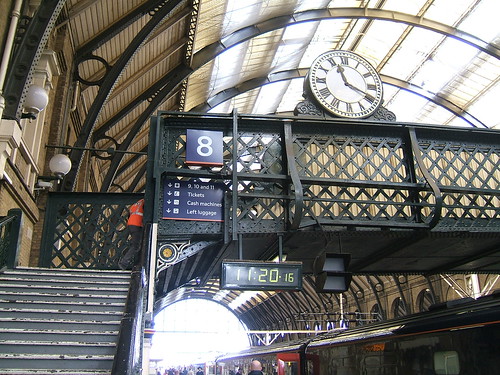
King's Cross: View of station footbridge showing one clockface from platform level. In the background, the horizontal drive shaft linking both clockfaces back to the mechanism in the office building can be seen.
Sadly, on my return in October 2009, I'm afraid the footbridge was being demolished as part of a major redevelopment at King's Cross. There's a post about the redevelopment here.

King's Cross: View of station footbridge being demolished.
Despite electrification, two of the four long-distance trains pictured below in 2009 remained diesel-powered!

King's Cross Station in 2009.
At the end of 2009, I ran a couple of technical training courses at King's Cross covering maintenance of our Tunnel Telephone system. The first of these was in the famous East Side Offices.

King's Cross Station East side offices viewed from York Way in 2009.

The rather grand stairs halfway along the East Side Offices building.

Imagine the generations of Railway Officers who have worn away the carved newel cap.
The second training course was held within King's Cross Power Signal Box. Since the training room had a panoramic view of King's Cross station throat and the track remodelling in progress, I had some difficulty keeping my attention on the business in hand.
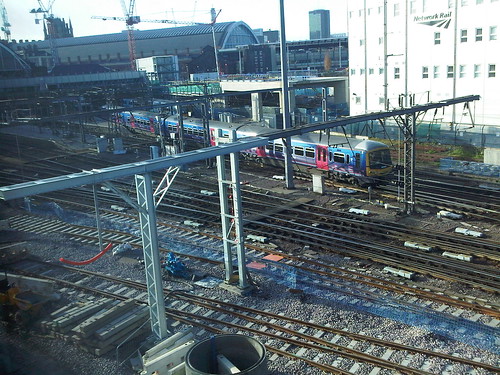
King's Cross station throat, viewed from the Power Signal Box.
Part of the remodelling involved an additional platform on the East Side, actually underneath the East Side offices. In the post about the redevelopment mentioned above, I reported that I'd been assured that the extra platform would not be '0' for technical reasons, but when I visited on 15th September 2010 I found that King's Cross now shared the rare distinction of possessing a Platform 0 (rendering my earlier post Platform Numbering Revisited out-of-date).
 King's Cross Station: Platform 0 looking north.
King's Cross Station: Platform 0 looking north.
Whilst on the topic of unusual platform numbers, in 2008 I'd been surprised to discover that, to satisfy Harry Potter fans, there was an opportunity to take a photograph of a luggage trolley disappearing through the wall leading to Platform 9-3/4!

A contractor takes a picture of a visitor at the entrance to platform 9-3/4 on 26-Feb-2008.
Returning in 2009 I was even more surprised to discover that the entrance had magically moved.

A visitor at the entrance to platform 9-3/4 on 21-Oct-2009 - location magically moved!
In June 2013, I first examined the now-completed redevelopment. In general, I approve of the treatment of the original buildings, although I'm not a fan of John McAslan's soaring concourse area (particularly when the supporting steel work is bathed in a rather lurid purple light).

King's Cross Station: The New Concourse illuminated in 2017.
But I applaud the restoration of the original appearance of Lewis Cubitt's 1852 train shed.

King's Cross Station: The simple but elegant end of the train shed is once-again revealed.
Related posts on other websites
London King's Cross railway station (Wikipedia)
Related posts on this website
Electrification Telephone Systems for British Rail (mentions Great Northern Suburban Electrification).
London's Terminal Stations (discusses King's Cross).
Northern City Line.
Redevelopment at King's Cross Station.
Class 373 Test Train to Grantham.
Rail Research UK Association Annual Conference 2017.
My Pictures
Where necessary, clicking on an image above will display an 'uncropped' view or, alternately, pictures from may be selected, viewed or downloaded, in various sizes, from the album listed:-
London: King's Cross Station.
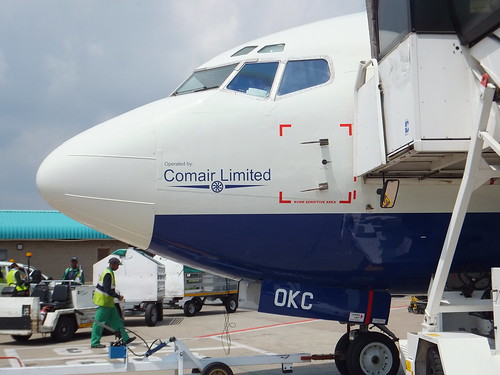 Comair 737 ZS-OKC on the ground at O. R. Tambo International Airport.
Comair 737 ZS-OKC on the ground at O. R. Tambo International Airport.
On my Safari Trip in February 2012 (described here, Boeing 737 ZS-OKC operated by Comair took me from O. R. Tambo to Livingstone. Whilst waiting to board, I noticed, marked in red on the side of the fuselage, the 'RVSM Sensitive Area'. I didn't know what 'RVSM' meant but it was not until I returned to the U.K. that I had an opportunity to research its significance (and it was almost another seven years before I wrote about it).
Although more modern techniques now exist, the basic method for determining an aircraft's altitude is by measuring barometric pressure with a 'pressure altimeter'. Increasing air traffic led to the introduction of a world-wide system of 'airways' with flying altitudes assigned to each aircraft to ensure safe vertical separation. Errors in measurement on the aircraft obviously potentially erode this separation. Continued growth in air traffic has led to improvements in pressure altimeters justifying an initial vertical separation of 2,000 feet between aircraft flying above Flight Level 290 ('Two,Nine,Zero') being reduced to 1,000 feet (as was already applied up to Flight Level 290). Of course, this requires suitably-tested equipment and the 'RVSM Sensitive Area' is kept pristine so that the air pressure sensed by the 'Pitot Tubes' feeding the pressure altimeter is not affected by turbulence.
Wikipedia has an article about this at Reduced vertical separation minima
.
The diagram below illustrating Non-RVSM and RVSM Flight Levels is from CSSI Inc:-

Non-RVSM and RVSM Flight Levels between FL290 and FL410.
CSSI Inc. also produced this sketch illustrating the effect of different errors on the altitude indicated to the pilot:-

Difference between Assigned and Actual Altitude.
There's more about altimeter setting on the excellent 'Skybrary' site here.
Of course, RVSM is just one feature of the amazing and complex Air Traffic Control system that world trade is dependent on.
Back in 2008, the post Work in progress stated my ambition regarding the backlog of draft blog posts to "Get 'em published, ready or not". How well did that work out? To my amazement, I have made 1,406 published posts at present, varying in length from the short to the quite long ("too long" do I hear you say?). But there are also 173 draft posts 'in the works', incomplete or awaiting further research.
The fact that I'm still working limits time available to write for the blog. I confess to still being a railway enthusiast (I think I prefer that term to 'railwayac' which I believe was used some time ago but unfortunately rhymes with 'maniac'). So that pastime consumes more of my available time (and is responsible for around half of the published posts). Finally, although my mobility is deteriorating with increasing age, my interest in travel is undiminished and any journey (even a modest one using the dreadful British railway system) supplies sufficient material for more unfinished posts.
The earlier 'Work in progress' post asked for the reader's indulgence regarding typographical and grammatical errors. Has that situation improved? Probably not. The editing software in 'Blogger' (which I still use) helpfully flags up spelling errors with a wiggly red underlining but, since it doesn't understand 'formatting directives', the editing screen is usually covered with highlighted formatting text, tending to hide the real errors. The other problem is that, just because a word is spelled correctly, it doesn't mean that's the word you intended. So, I will plod on, as best I can.
In the post An Apology, which appeared in 2009, I wrote about the perils of spelling place names, before digressing about L.M.S. signal box nameboards. For balance, below is a picture of a Great Western signal box nameboard. As I commented in the post here:-
The Great Western liked to dignify their signal boxes with a single, cast-iron name plate showing the name in full so I noticed the imposing length of the sign mounted on side facing the tracks reading 'SUTTON BRIDGE JUNCTION SIGNAL BOX'.
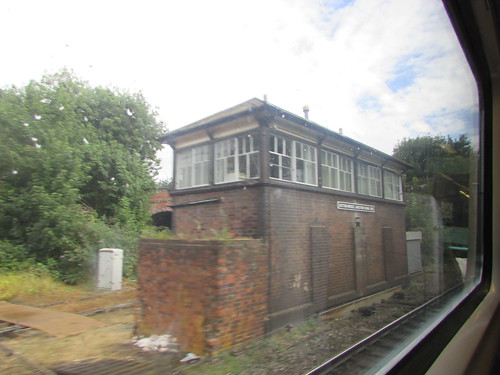
Shrewsbury area rail: Sutton Bridge Junction signal box, 28th July 2018.
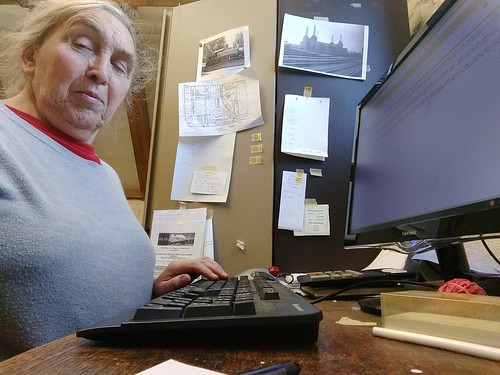
Jan 'Blogging', 27th January 2019.
During the first of two visits I made to to Myanmar in 2017, on Sunday 7th May 2017, I travelled by train from Kalaw to Shwe Nyaung, as briefly described in the post here. More technical comments are in this present post.
The published timings of the train were:-
13:30 depart Kalaw
15:40 depart Heho
17:00 arrive Shwenyaung
This is train 141 booked to leave Thazi at 7.00 a.m. (Which I'd caught in 2016 when travelling from Thazi to Kalay as described in posts Thazi-Kalaw and Thazi - Kalaw (part 2)).
There was a particular reason I'd chosen to to now make the journey beyond Kalaw to Shwe Nyaung - I'd found out there was a circular loop or spiral, descending in our direction of travel between Heho and Shwe Nyaung. I might have been tempted to catch an ascending train, when the loco would be working hard but travelling on a descending train fitted in better with my overall programme and certainly emphasised the importance of brakes!
Kalaw Station (mileage: 369)
Division 4 of Myanma Railways
Kalaw is the headquarters of Division 4 of Myanma Railways and the Divisional offices face the station across the tracks.
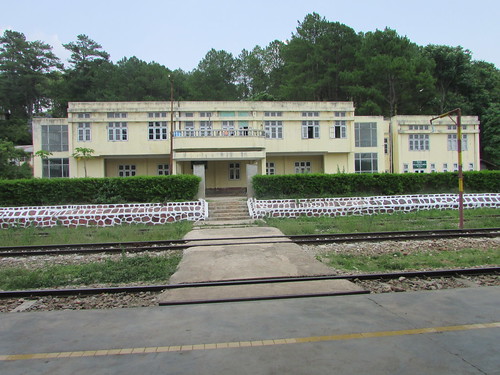 Kalaw Division Railway Offices stand opposite Kalaw Station.
Kalaw Division Railway Offices stand opposite Kalaw Station.
Map showing extent of Division 4
Click on map for larger view
Layout of Station
I'd first visited Kalaw Station (elevation 4297 feet) in 2016 when I'd arrived at Kalaw by train but I'd also studied the station the following day when travelling around Kalaw by road. In 2017, I first visited the station by road on our arrival on Saturday because my guide, Thandar Oo, wanted to confirm the train timings. So my pictures in the album Kalaw Station consolidates the pictures taken on these various visits. On the Sunday of our train journey to Shwe Nyaung, we arrived at the station nice and early so that I could take more pictures which form the start of the album Kalaw - Shwe Naung by train.
The station is provided with one broad platform situated on the left looking towards Shwe Naung.
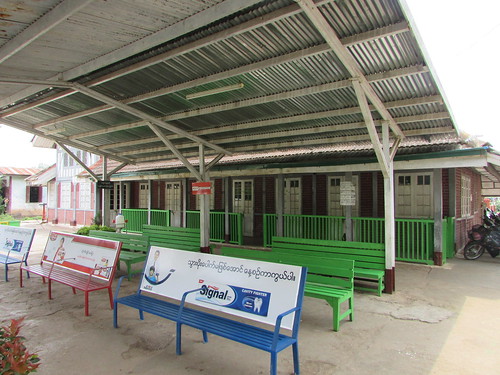
Kalaw Station showing the covered waiting area on the broad platform.
There is a main line, passing loop, goods loop and three sidings with stop blocks. Points are controlled from single lever point frames with Trapped Key Interlocking arrangements supervised by the Station Master. Points are equipped with the usual semi-derelict point indicators.
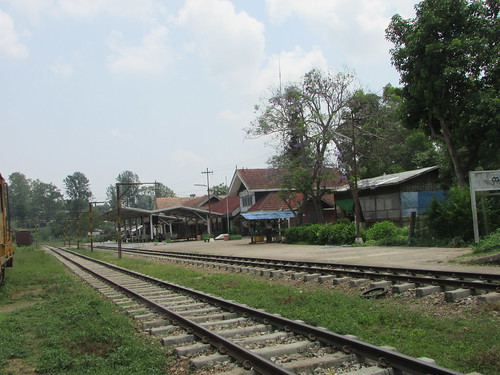
General view of Kalaw Station looking towards Thazi.
An Outer Home signal approaching the station is provided in each direction and both are controlled from a Signal Capstan on the station platform. I'd previously seen these Signal Capstans (which I sometimes called 'windlasses') on the line to Maymyo.
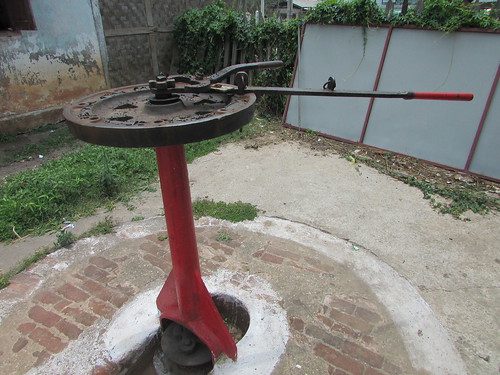
Outer Home Signal Capstan at Kalaw (Up/Down)
The Outer Home signals are preceded by fixed Distant signals. There is a level crossing with manual gates on the Thazi side of the station. Movements over the level crossing and through points are authorised by a green hand signal from the pointsman/crossing keeper.
The usual diagram in the Station Master's office makes the arrangements clearer:-
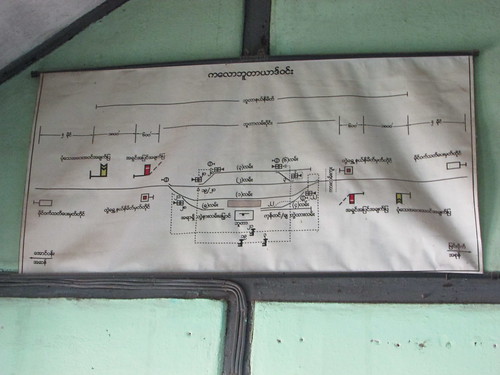
Track diagram in Station Master's office at Kalaw. Shwe Naung is to the left, Thazi to the right.
Click here for larger view
Kalaw: Arrival and Departure of my train
A member of the station staff (whom I'll call the 'pointsman') was despatched to to the Signal Capstan to make sure that the Outer Home was 'clear' for the approaching train, then he carried on to the loop points to check that they were correctly set and 'clipped' (secured with a point clip, similar to a 'G'-clamp, and padlocked), ready to give a 'green' handsignal to the approaching train to authorise the train's entry to the platform. Since there's also a level crossing next to the points, a Crossing Keeper also appeared to push the two hand operated gates across the road after which he also displayed a 'green' handsignal. The 2,000 horse power diesel-electric locomotive and its train slowly bounced over the pointwork and crawled into the platform.
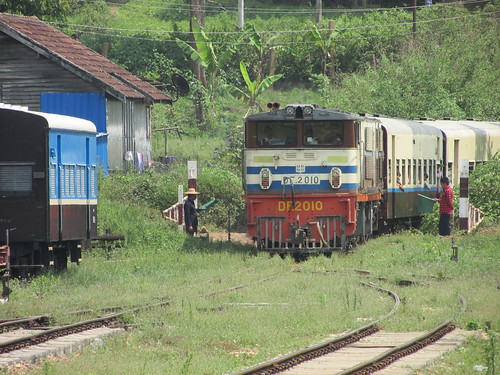
Kalaw - Shwe Naung by train: DF.2010 arriving from Thazi. Pointsman on left, Crossing Keeper on right, both displaying green flags.
Another member of station staff stood ready on the platform to collect a document pouch offered by the Second Man on the locomotive. I assume the pouch surrendered the 'Line Clear' form which had authorised departure from the previous Block Station.
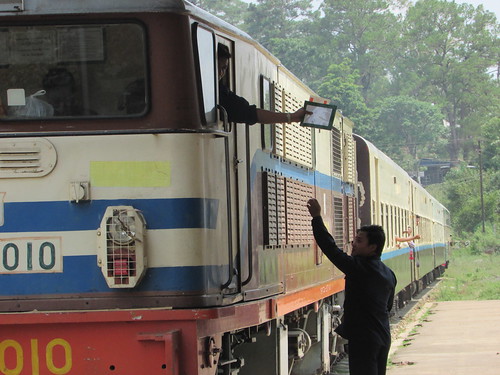
Kalaw - Shwe Naung by train: My train arriving at Kalaw late at 14:57.
I'd not seen a document pouch in use previously. A cane 'hoop' is more common, as shown below.
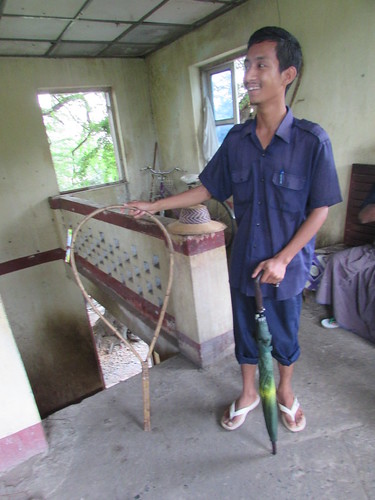
Myo Haung Signal Cabin, Mandalay: A railwayman displays the cane hoop with the vital Paper Line Clear Form attached. This form is issued by the Controller and, when received by the driver, authorises the train movement.
The train comprised four bogie coaches and two bogie goods vans, one with 'duckets' (a part-glazed lookout used by the guard). There was the usual flurry of activity as passengers boarded and alighted and freight was loaded and unloaded. After a plaintive sounding of the locomotive air horn, we quietly departed.
Track maintenance gang
Not long after leaving Kalaw, we slowed right down passing a Permanent Way gang, apparently carrying out spot replacement of rotten wooden sleepers with reinforced concrete ones.
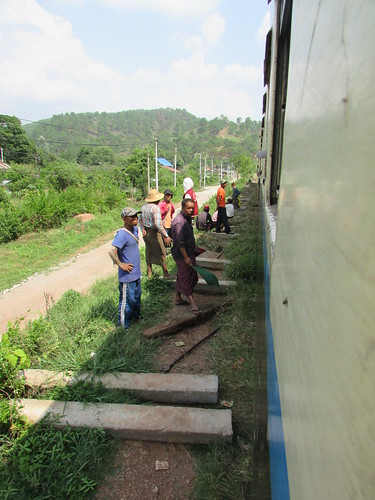
Track Repairs.
The line to Aung Ban
The line twisted and turned over the undulating route across the mountains meaning that our locomotive was working quite hard at times.
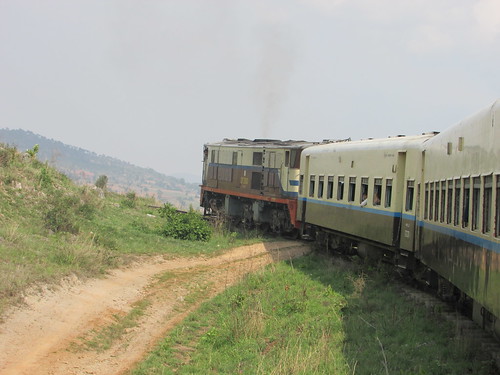
Kalaw - Shwe Naung by train.
Aung Ban Station (mileage: 376)
Our first stop was at Aung Ban (elevation 4219 feet, just 78 feet lower than Kalaw Station). As at Kalaw, approaching the station in each direction there is a fixed Distant signal. The design of these varies quite a bit from site to site.
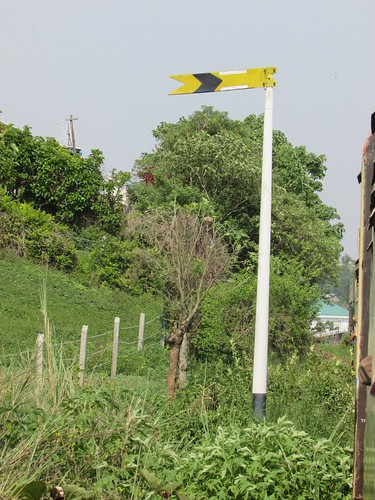
Kalaw - Shwe Naung by train: Aung Ban semaphore fixed distant.
The distant is followed by an Outer Home signal the design of which can vary. Both upper-quadrant and lower quadrant arrangements are in use.
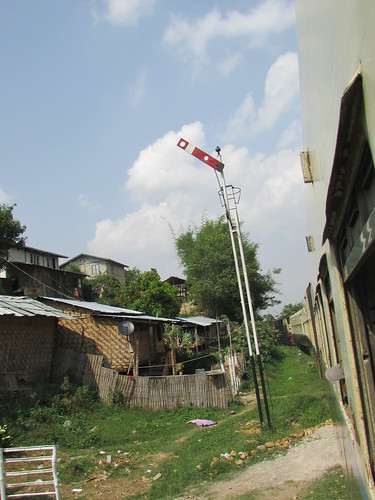
Kalaw - Shwe Naung by train: Aung Ban upper-quadrant semaphore stop signal.
I'd visited Aung Ban by road four days previously, on my way from Heho Airport to Loikaw. In addition to the main line and passing loop, there are four siding loops, plus the diverging branch line to Loikaw. At the Kalaw end of the station, there's a large water tank on a steel truss support to feed a derelict water column, with a swan-neck cast delivery pipe.
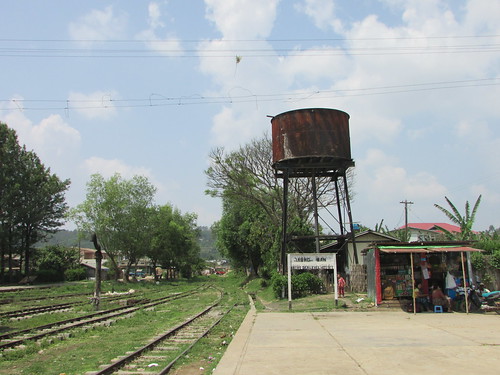
Aung Ban Station: Derelict water column and steel water tower.
Track 4 stabled a coach and an old bogie goods van probably used by railway workers as they were next to Railway Gang Car ED/RGC113 used for track maintenance.
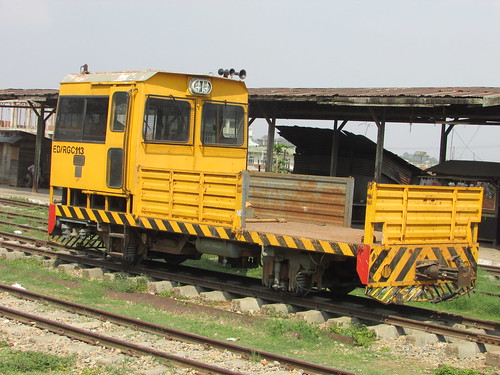
Kalaw - Shwe Naung by train: Railway Gang Car ED/RGC113 at Aung Ban.
After a brief stop, we set off again.
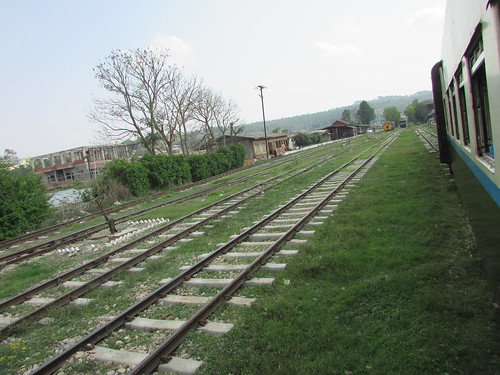
Kalaw - Shwe Naung by train: Leaving Aung Ban, showing sidings on the left and single platform on the right. Note the single lever point frame.
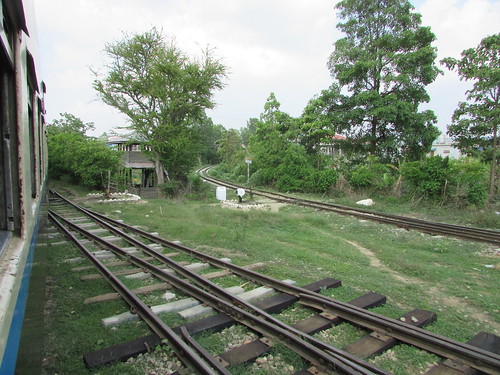
Kalaw - Shwe Naung by train: Leaving Aung Ban, showing branch to Loikaw diverging, two single lever point frames and a point indicator. Note raised hut.
Once again, we were in countryside, sometimes twisting and turning around hills, sometimes overlooking grazing herds and, at least once, passing over a watercourse on a steel girder bridge set on tall stone piers before reaching Kan Na.
Kan Na Station (mileage: 384.75)
We stopped briefly at the rural station of Kan Na. I was surprised to see a lower-quadrant semaphore 'stop' signal beyond the platform, obstinately at 'danger', even as we drew up to the signal. Presently, a pointsman cleared the signal (arm pointing downwards, as you'd expect a lower quadrant to do) and we departed. The signal was protecting a facing point leading to a short siding with a stop block, so I concluded at the time that we were about to descend a reasonably severe gradient but, lacking a gradient diagram, I can't be certain..

Kalaw - Shwe Naung by train: Passing Kan Na semaphore fixed distant.
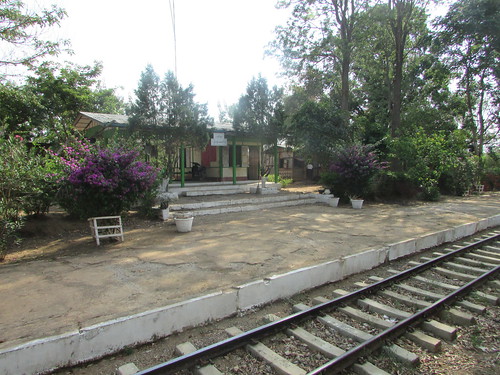
Kalaw - Shwe Naung by train: Kan Na station.
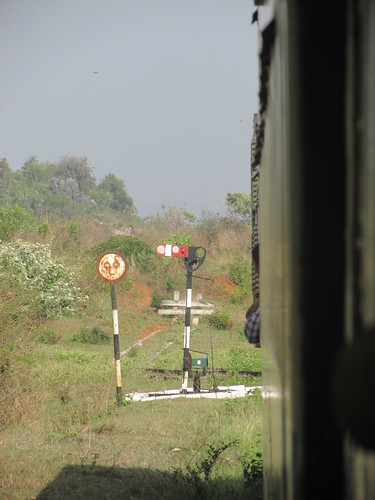
Kalaw - Shwe Naung by train: Kan Na station showing semaphore stop signal with Trapped Key locking box, point indicator, hand point lever and separate warning sign.
As we continued towards Heho, the scenery was initially quite rugged but then turned into a high plain, with extensive vegetable-growing and villagers tending the crop.
Heho Station (mileage: 404)
We passed Heho Airport on our left and then the fixed semaphore distant for Heho. The Outer Home signal was 'off' and I managed a reasonable picture. A square concrete foundation has two short steel projections to which the signal post is bolted. The post is formed of two parallel channel-sections of different lengths held parallel by bolting-through nicely-cast spacer blocks. Near the base of the signal, a large pulley wheel diverts the signal operating wire vertically up the post. Near the top of the shorter channel section, a lever is pivoted so that the pull of the signal wire on one end of the lever is converted into a push on the solid rod which extends upwards to operate the signal arm. I was amused to note that three weights had been wired to the end of the lever to ensure that the signal arm returns to danger when the signal wire slackens. The arm itself is pivoted near the top of the longer channel-section which is terminated in a neat, cast finial. On this particular example, the signal arm appeared quite elderly - corrugated steel bolted to a cast spectacle and apparently of the pattern used by The Railway Signal Co, where an arm that looks as if designed to be lower-quadrant is arranged as upper-quadrant. The back-blinder was in the correct position (had the signal been illuminated) and spectacle glasses were still intact (both 'clear' but I couldn't determine whether glass, plastic or metal gauze). Variations of this pattern are found all over Myanmar and, as here, they often lack an access ladder. At Heho, this signal is controlled from a signal capstan on the station platform.
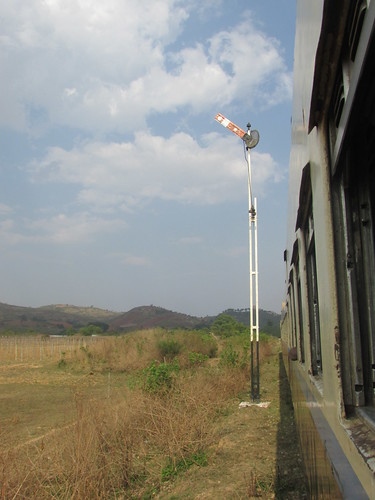
Kalaw - Shwe Naung by train: Semaphore stop signal, Heho.
And so we arrived at Heho where I took plenty of pictures whilst the various vendors plied their wares. Two days later, I made a second visit by road, met the station master and took more pictures (in the album Heho Station). Heho has the main line, passing loop, and one siding loops with moveable scotches (a second siding loop has been abandoned). Points, equipped with point indicators, are controlled from single lever point frames with Trapped Key Interlocking arrangements supervised by the Station Master.
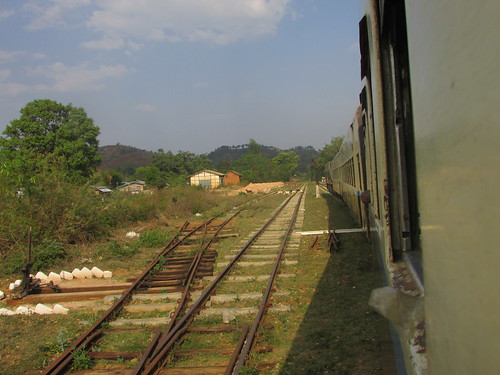
Kalaw - Shwe Naung by train: Entering Heho, showing single lever point frame and abandoned water column.
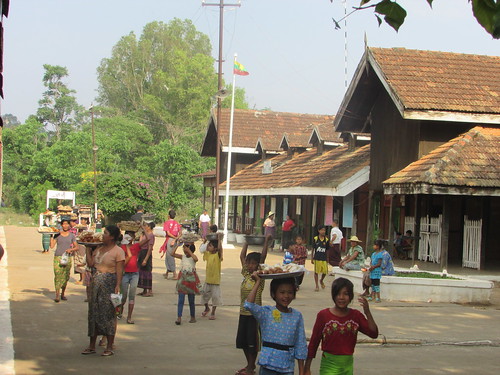
Kalaw - Shwe Naung by train: Heho.
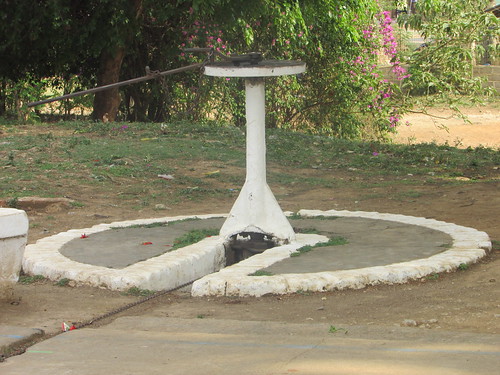
Kalaw - Shwe Naung by train: Heho Station. Signal Capstan for Up Outer Signal.
During my second visit to Heho station, I was able to photograph the track diagram in the Station Master's Office.
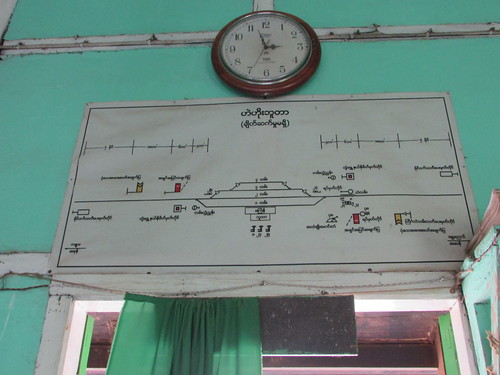
Track diagram in Station Master's Office, Heho. Kalaw is to the left, Shwe Naung to the right.
Click here for larger version.
Unlike, for instance, Kalaw the signal capstan on the platform at Heho only operates the Outer Home Signal for trains heading towards Shwe Nyaung because the Outer Signal heading towards Kalay protects a set of 'trap' points. So, in this case, the signal is operated using a nearby single lever signal frame with Trapped Key locking box shown in the picture below. Again, I assume that this is because the gradient is falling towards Heho but I haven't confirmed this. This signal is similar in design to the other Heho Outer signal illustrated above but, in this case, the 'modern' signal arm has no spectacle, is arranged as an upper-quadrant and is provided with a signal ladder.
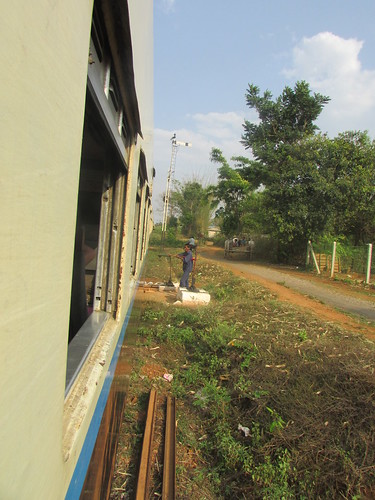
Kalaw - Shwe Naung by train: Leaving Heho, showing semaphore stop signal, single lever signal frame with Trapped Key locking box and Hand point lever for 'trap' points. Note the bullock cart on the roadway.
The Spiral at Ba Wa Sam Sa Ra Bridge
After a lot more twisting and turning to pick our way through the contours of this mountainous area, we came to the Spiral. To lose height rapidly, the railway takes a descending single spiral and crosses under the high level line at the Ba Wa Sam Sa Ra Bridge. After passing a fixed distant, I was not surprised that we came to a 'stop' signal at danger with another fixed distant mounted under the 'stop' arm. This was the last chance for the driver to satisfy himself that the train brakes were operating correctly. Then the signal came 'off' and we gingerly moved forwards.
This was a most curious signal with a short post of channel section painted alternately black and white, rather than white (not that unusual) but with three short lengths of 'rebar' welded to the post, one above the other, to form a ladder. The stop signal arm was corrugated steel, probably old and attached to a spectacle which, from its proportions, was also old. Like the two signals I'd spotted at Kan Na, it was built to be lower-quadrant but, when the handsignalman had 'cleared' the signal, the arm was 'up', not 'down'. As we passed the signal, I looked in vain for any operating mechanism and reluctantly decided the handsignalman had climbed up the 'rebar' to somehow alter the signal aspect. Incidentally, the painted 'vee' on the front of the distant signal arm mounted on the same post was white, not black as usually found in Myanmar although the 'vee' on the rear of the arm was the expected black.
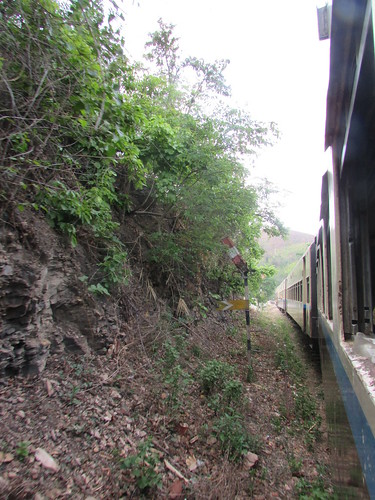
Kalaw - Shwe Naung by train: Semaphore stop signal and fixed distant signal, Ba Wa Sam Sa Ra Bridge.
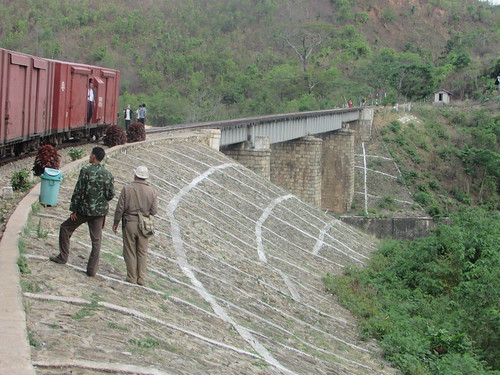
Kalaw - Shwe Naung by train: View looking back, immediately after passing over the Ba Wa Sam Sa Ra Bridge at high level.
With plenty of braking to control our speed, the train then descended the spiral and passed under the bridge we'd crossed over around three minutes earlier.
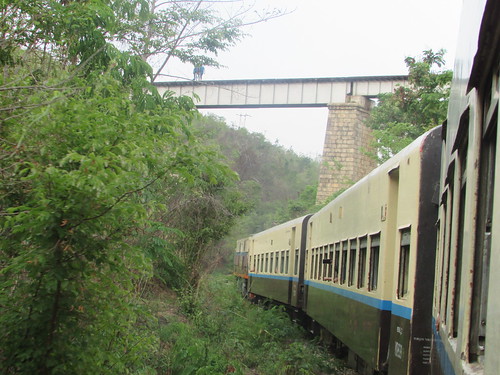
Kalaw - Shwe Naung by train: View looking ahead, immediately before passing under the Ba Wa Sam Sa Ra Bridge at low level.
I was quite impressed by our descent of the spiral.
Shwe Nyaung Station (mileage: 369)
It took us around half an hour to travel from the Spiral to Shwe Nyaung station but, by that time, I was getting fairly tired and didn't pay too much attention, I'm afraid.
Shwer Nyaung has the main line, passing loop, and a couple of siding loops. Points, some equipped with point indicators, are controlled from single lever point frames with Trapped Key Interlocking arrangements supervised by the Station Master.
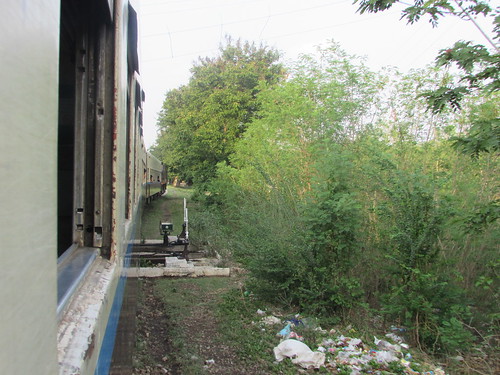
Kalaw - Shwe Naung by train: Arriving at Shwe Naung, with two Single lever point frames, one with point indicator.
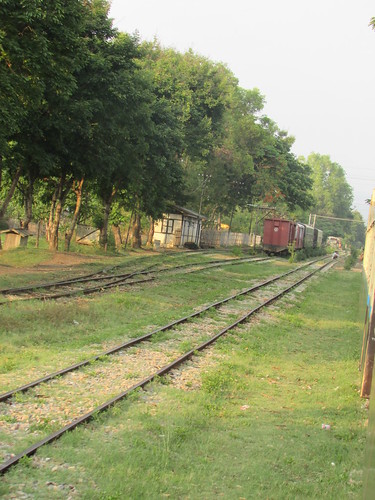
Kalaw - Shwe Naung by train: Arriving at Shwe Naung: L-R: Siding, siding, loop, platform line.
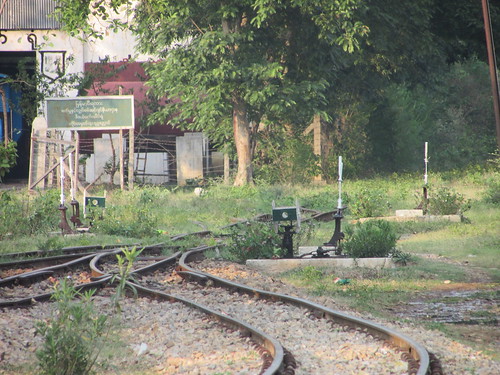
Shwe Naung Station:
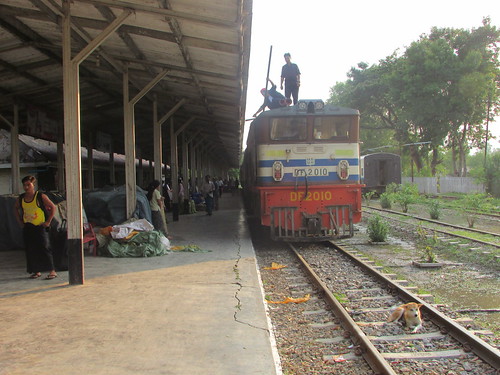
Shwe Naung Station: DF.2010 on arrival. Second man and mechanic on loco roof performing checks (fuel?). Note dog between the rails.
History
History of rail transport in Myanmar (Wikipedia).
Related posts in my blog
On to Inle Lake.
All my Myanma Railways posts.
My Pictures
Pictures in this article can be viewed uncropped by clicking on the image. To view in other resolutions or download, select from the albums below:-
Kalaw - Shwe Naung by train.
Kalaw Station (2016, 2017).
Aung Ban Station.
Heho Station.
All my Myanma Railways Pictures.












































































